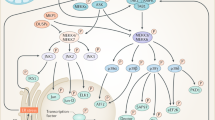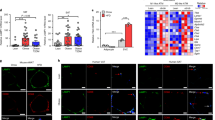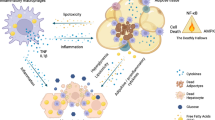Abstract
Obesity is associated with chronic low-grade inflammation. Inflammatory signals interfere with insulin action and disrupt metabolic homeostasis. The c-Jun N-terminal kinase (JNK) has been identified as a central mediator of insulin resistance. Recent studies showed that in obesity compromising endoplasmic reticulum (ER) function results in insulin resistance and type 2 diabetes that are dependent on JNK activation. In contrast, enhancing ER function in transgenic mice or by the use of chemical chaperones protects against diet-induced insulin resistance. Hence, ER stress and the related signaling networks present a critical mechanism underlying obesity-induced JNK activity, inflammatory response and insulin resistance.
This is a preview of subscription content, access via your institution
Access options
Subscribe to this journal
Receive 12 print issues and online access
$259.00 per year
only $21.58 per issue
Buy this article
- Purchase on Springer Link
- Instant access to full article PDF
Prices may be subject to local taxes which are calculated during checkout
Similar content being viewed by others
References
Hotamisligil GS . Inflammation and metabolic disorders. Nature 2006; 444: 860–867.
Wellen KE, Hotamisligil GS . Inflammation, stress, and diabetes. J Clin Invest 2005; 115: 1111–1119.
Wellen K, Fucho R, Gregor MF, Furuhashi M, Morgan C, Lindstad T et al. Coordinated regulation of nutrient and inflammatory responses by STAMP2 is essential for metabolic homeostasis. Cell 2007; 129: 537–548.
Hirosumi J, Tuncman G, Chang L, Gorgun CZ, Uysal KT, Maeda K et al. A central role for JNK in obesity and insulin resistance. Nature 2002; 420: 333–336.
Tuncman G, Hirosumi J, Solinas G, Chang L, Karin M, Hotamisligil GS . Functional in vivo interactions between JNK1 and JNK2 isoforms in obesity and insulin resistance. Proc Natl Acad Sci USA 2006; 103: 10741–10746.
Furuhashi M, Tuncman G, Görgün CZ, Makowski L, Atsumi G, Vaillancourt E et al. Treatment of diabetes and atherosclerosis by inhibiting fatty-acid-binding protein aP2. Nature 2007; 447: 959–965.
Furuhashi M, Fucho R, Gorgun CZ, Tuncman G, Cao H, Hotamisligil GS . Adipocyte/macrophage fatty acid-binding proteins contribute to metabolic deterioration through actions in both macrophages and adipocytes in mice. J Clin Invest 2008; 118: 2640–2650.
Vallerie SN, Furuhashi M, Fucho R, Hotamisligil GS . A predominant role for parenchymal c-Jun amino terminal kinase (JNK) in the regulation of systemic insulin sensitivity. PLoS 2008; 3: e3151.
Hotamisligil GS . Role of endoplasmic reticulum stress and c-Jun NH2-terminal kinase pathways in inflammation and origin of obesity and diabetes. Diabetes 2005; 54 (Suppl 2): S73–S78.
Gregor MF, Hotamisligil GS . Thematic review series: adipocyte biology. Adipocyte stress: the endoplasmic reticulum and metabolic disease. J Lipid Res 2007; 48: 1905–1914.
Ozcan U, Cao Q, Yilmaz E, Lee AH, Iwakoshi NN, Ozdelen E et al. Endoplasmic reticulum stress links obesity, insulin action, and type 2 diabetes. Science 2004; 306: 457–461.
Ozcan U, Yilmaz E, Ozcan L, Furuhashi M, Vaillancourt E, Smith RO et al. Chemical chaperones reduce ER stress and restore glucose homeostasis in a mouse model of type 2 diabetes. Science 2006; 313: 1137–1140.
Acknowledgements
I am grateful for the contribution of fellows and students to the studies presented here. The research programs in Hotamisligil laboratory are supported by grants from the National Institutes of Health USA, American Diabetes Association and Juvenile Diabetes Research Foundation.
Author information
Authors and Affiliations
Corresponding author
Additional information
Conflict of interest
Gokhan S Hotamisligil has received lecture fees from Merck, Schering Plough, Pfizer and Glaxo Smith Kline and is a member of the SAB of Lipomics Technologies Inc. and Syndexa Pharmaceuticals. In addition, Gokhan S Hotamisligil owns stock options with Lipomics Technologies Inc. and Syndexa Pharmaceuticals and has received grant support from Syndexa.
Rights and permissions
About this article
Cite this article
Hotamisligil, G. Inflammation and endoplasmic reticulum stress in obesity and diabetes. Int J Obes 32 (Suppl 7), S52–S54 (2008). https://doi.org/10.1038/ijo.2008.238
Published:
Issue Date:
DOI: https://doi.org/10.1038/ijo.2008.238
Keywords
This article is cited by
-
Evidence gaps on weight gain in people living with HIV: a scoping review to define a research agenda
BMC Infectious Diseases (2023)
-
Mothers’ cafeteria diet induced sex-specific changes in fat content, metabolic profiles, and inflammation outcomes in rat offspring
Scientific Reports (2021)
-
The capacity of differentiation of stromal vascular fraction cells into beige adipocytes is markedly reduced in subjects with overweight/obesity and insulin resistance: effect of genistein
International Journal of Obesity (2021)
-
Beneficial effect of ER stress preconditioning in protection against FFA-induced adipocyte inflammation via XBP1 in 3T3-L1 adipocytes
Molecular and Cellular Biochemistry (2020)
-
Disrupted sphingolipid metabolism following acute clozapine and olanzapine administration
Journal of Biomedical Science (2018)



